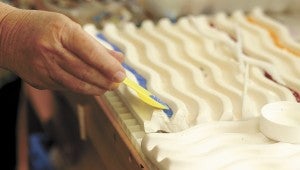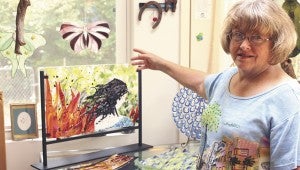Fused in the fire
Published 8:54 pm Wednesday, July 22, 2015
All glass is born of fire, but it doesn’t necessarily take fire to make it into something beautiful.
All it really takes is temperatures between 1,200 and 1,550 degrees Fahrenheit and a lot of talent.
At the lower end of the spectrum, glass will slump into or around a mold. Slightly higher temperatures will give the glass round edges and a shiny appearance. Higher still will make pieces of glass stick together. And even higher than that, glass will fully join together.
These are temperatures that can only be achieved in a kiln. Cynthia Quesenberry got her first kiln in 2007 after an interest in glass art from her younger days was reignited.
She worked with stained glass as a younger woman back in the ‘70s. “That’s where I learned to cut and shape glass and put it together,” she said.
But in the last decade, she became interested in the art of glass fusion — where different pieces of glass come together in her hands, and then in the kiln, to create art.
“I started seeing things in shows,” she said. “It looked so interesting and intriguing to me, and I wanted to know how to do it.”
Quesenberry’s art ranges from jewelry to larger pieces designed for display. From fish to faces and especially functional items like plates and bowls, anything is fair game to be the subject of her work.
“The color, the way the light comes through it, it inspires me a lot,” she said.
Much of Quesenberry’s work comes from tiny grains of colored glass that look a lot like festive sugar crystals. But these aren’t the kind of thing you would want to eat.
She shapes the glass into molds and fires it in her kiln, making it whatever shape she wants. She then can cut it and fit it onto another piece, which ultimately can be fired again for the final design. Detailed work can be done with a hand-held torch.

Cindy Quesenberry demonstrates how she uses tiny pieces of colored glass to make rods of glass she will cut into shapes for a project.
“It’s inspiring to me because of the way it turns out and the way it performs in the kiln,” she said.
Working with such high heat can be very dangerous, as are a lot of art processes. Quesenberry has been burned a few times, but not seriously.
“I am very careful working with the torch and handling hot glass,” she said, noting she gets cut more often than burned. “Working with the materials and the equipment requires a great deal of respect, especially for personal safety and the safety of the surroundings of the studio.”
Kilns must be attended closely and ventilated properly after use, Quesenberry said. Combustible materials are prohibited anywhere near the kiln.
The safety concerns don’t stop kids from also enjoying glass fusion art, added Quesenberry, who teaches art at the Renaissance School of the Arts.
“Once they learn how to cut a piece of glass, they just can’t stand it — they have to keep cutting,” she said of her students. “Teaching has brought me out of the rut of glass fusing. They even give me ideas and inspire me to take a project on.”

Cindy Quesenberry shows a piece she created for the “Fahrenheit 451”-themed show at the Suffolk Art Gallery.
Glass fusing isn’t for everyone or even every artist. Even Quesenberry has to take a break sometimes for her other artistic passions — clay, which requires kiln temperatures even hotter than glass to set, and printmaking.
“There are so many creative people out there,” Quesenberry said. “The variety of glass you can use to make things is so much fun.”








